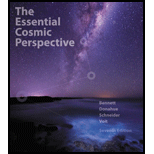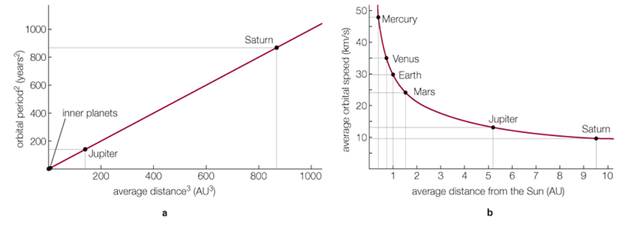
The Essential Cosmic Perspective (7th Edition) - Standalone book
7th Edition
ISBN: 9780321928085
Author: Jeffrey O Bennett, Megan O. Donahue, Nicholas Schneider, Mark Voit
Publisher: PEARSON
expand_more
expand_more
format_list_bulleted
Textbook Question
Chapter 3, Problem 6VSC
Use the information in the graphs to answer the following questions.
Check your understanding of some of the many types of visual information used in astronomy. For additional practice, try the Chapter 3  Visual Quiz at Mastering Astronomy.
Visual Quiz at Mastering Astronomy.

6. Suppose Figure a showed a planet on the red line directly above a value of 1000 AU3 along the horizontal axis. On the vertical axis, this planet would be at _______._____
a. 1000 year2
b. 10002 years
c.
d. 100 years
Expert Solution & Answer
Want to see the full answer?
Check out a sample textbook solution
Students have asked these similar questions
Q: What is the direction of the force on the current carrying conductor in the
magnetic field in each of the cases 1 to 8 shown below?
(1)
B
B
B into page
X X X
x
X X X X
(2)
B
11 -10°
B
x I
B
I out of page
(3)
I into page
(4)
B out of page
out of page
I
N
N
S
x X X X
I
X
X X X
I
(5)
(6)
(7)
(8)
S
Q: What is the direction of the magnetic field at point A, due to the current I in a
wire, in each of the cases 1 to 6 shown below? Note: point A is in the plane of the
page.
▪A
I
I
▪A
(1)
(2)
▪A
• I (out of page)
(3)
▪A
I
x I (into page)
▪A
▪A
I
(4)
(5)
(6)
A tennis ball is thrown into the air with initial speed vo=46 m/s and angle (theta) 38 degrees from the ground. Find the distance it travels (x) when it hits the ground.
Chapter 3 Solutions
The Essential Cosmic Perspective (7th Edition) - Standalone book
Ch. 3 - Prob. 1VSCCh. 3 - Use the information in the graphs to answer the...Ch. 3 - Use the information in the graphs to answer the...Ch. 3 - Use the information in the graphs to answer the...Ch. 3 - Use the information in the graphs to answer the...Ch. 3 - Use the information in the graphs to answer the...Ch. 3 - Use the information in the graphs to answer the...Ch. 3 - In what way is scientific thinking natural to all...Ch. 3 - Prob. 2EAPCh. 3 - What is a lunar calendar? How can it be kept...
Ch. 3 - What do we mean by a model in science? Briefly...Ch. 3 - What do we mean by the Ptolemaic model? How did...Ch. 3 - What was the Copernican revolution, and how did it...Ch. 3 - What is an ellipse? Define its foci, semimajor...Ch. 3 - State and explain the meaning of each of Kepler’s...Ch. 3 - Describe the three hallmarks of science and...Ch. 3 - What is the difference between a hypothesis and a...Ch. 3 - Each of the following statements makes some type...Ch. 3 - Each of the following statements makes some type...Ch. 3 - Each of the following statements makes some type...Ch. 3 - Each of the following statements makes some type...Ch. 3 - Each of the following statements makes some type...Ch. 3 - Each of the following statements makes some type...Ch. 3 - Each of the following statements makes some type...Ch. 3 - Each of the following statements makes some type...Ch. 3 - Each of the following statements makes some type...Ch. 3 - Prob. 20EAPCh. 3 - Choose the best answer to each of the following....Ch. 3 - Choose the best answer to each of the following....Ch. 3 - Choose the best answer to each of the following....Ch. 3 - Choose the best answer to each of the following....Ch. 3 - Choose the best answer to each of the following....Ch. 3 - Choose the best answer to each of the following....Ch. 3 - Choose the best answer to each of the following....Ch. 3 - Choose the best answer to each of the following....Ch. 3 - Choose the best answer to each of the following....Ch. 3 - Choose the best answer to each of the following....Ch. 3 - Prob. 31EAPCh. 3 - Earth’s Shape. It took thousands of years for...Ch. 3 - Prob. 33EAPCh. 3 - Prob. 34EAPCh. 3 - Prob. 35EAPCh. 3 - Prob. 36EAPCh. 3 - Prob. 37EAPCh. 3 - Prob. 38EAPCh. 3 - Halley Orbit. Halley’s comet orbits the Sun every...Ch. 3 - Prob. 40EAPCh. 3 - 41. The Importance of Ancient Astronomy. Why was...Ch. 3 - Prob. 42EAPCh. 3 - Prob. 43EAPCh. 3 - The Galileo Affair. In recent years. the Roman...Ch. 3 - Prob. 45EAP
Knowledge Booster
Learn more about
Need a deep-dive on the concept behind this application? Look no further. Learn more about this topic, physics and related others by exploring similar questions and additional content below.Similar questions
- Problem 04.08 (17 points). Answer the following questions related to the figure below. ථි R₁ www R₂ E R₁ www ли R₁ A Use Kirchhoff's laws to calculate the currents through each battery and resistor in terms of R1, R2, E1, & E2. B Given that all the resistances and EMFs have positive values, if E₁ > E2 and R₁ > R2, which direction is the current flowing through E₁? Through R₂? C If E1 E2 and R₁ > R2, which direction is the current flowing through E₁? Through R2?arrow_forwardA 105- and a 45.0-Q resistor are connected in parallel. When this combination is connected across a battery, the current delivered by the battery is 0.268 A. When the 45.0-resistor is disconnected, the current from the battery drops to 0.0840 A. Determine (a) the emf and (b) the internal resistance of the battery. 10 R2 R₁ ww R₁ Emf 14 Emf Final circuit Initial circuitarrow_forwardA ball is shot at an angle of 60° with the ground. What should be the initial velocity of the ball so that it will go inside the ring 8 meters away and 3 meters high. Suppose that you want the ball to be scored exactly at the buzzer, determine the required time to throw and shoot the ball. Full solution and figure if there is.arrow_forward
- Correct answer please. I will upvote.arrow_forwardDefine operational amplifierarrow_forwardA bungee jumper plans to bungee jump from a bridge 64.0 m above the ground. He plans to use a uniform elastic cord, tied to a harness around his body, to stop his fall at a point 6.00 m above the water. Model his body as a particle and the cord as having negligible mass and obeying Hooke's law. In a preliminary test he finds that when hanging at rest from a 5.00 m length of the cord, his body weight stretches it by 1.55 m. He will drop from rest at the point where the top end of a longer section of the cord is attached to the bridge. (a) What length of cord should he use? Use subscripts 1 and 2 respectively to represent the 5.00 m test length and the actual jump length. Use Hooke's law F = KAL and the fact that the change in length AL for a given force is proportional the length L (AL = CL), to determine the force constant for the test case and for the jump case. Use conservation of mechanical energy to determine the length of the rope. m (b) What maximum acceleration will he…arrow_forward
- 9 V 300 Ω www 100 Ω 200 Ω www 400 Ω 500 Ω www 600 Ω ww 700 Ω Figure 1: Circuit symbols for a variety of useful circuit elements Problem 04.07 (17 points). Answer the following questions related to the figure below. A What is the equivalent resistance of the network of resistors in the circuit below? B If the battery has an EMF of 9V and is considered as an ideal batter (internal resistance is zero), how much current flows through it in this circuit? C If the 9V EMF battery has an internal resistance of 2 2, would this current be larger or smaller? By how much? D In the ideal battery case, calculate the current through and the voltage across each resistor in the circuit.arrow_forwardhelparrow_forwardIf the block does reach point B, how far up the curved portion of the track does it reach, and if it does not, how far short of point B does the block come to a stop? (Enter your answer in m.)arrow_forward
- Truck suspensions often have "helper springs" that engage at high loads. One such arrangement is a leaf spring with a helper coil spring mounted on the axle, as shown in the figure below. When the main leaf spring is compressed by distance yo, the helper spring engages and then helps to support any additional load. Suppose the leaf spring constant is 5.05 × 105 N/m, the helper spring constant is 3.50 × 105 N/m, and y = 0.500 m. Truck body yo Main leaf spring -"Helper" spring Axle (a) What is the compression of the leaf spring for a load of 6.00 × 105 N? Your response differs from the correct answer by more than 10%. Double check your calculations. m (b) How much work is done in compressing the springs? ☑ Your response differs significantly from the correct answer. Rework your solution from the beginning and check each step carefully. Jarrow_forwardA spring is attached to an inclined plane as shown in the figure. A block of mass m = 2.71 kg is placed on the incline at a distance d = 0.285 m along the incline from the end of the spring. The block is given a quick shove and moves down the incline with an initial speed v = 0.750 m/s. The incline angle is = 20.0°, the spring constant is k = 505 N/m, and we can assume the surface is frictionless. By what distance (in m) is the spring compressed when the block momentarily comes to rest? m m 0 k wwwwarrow_forwardA block of mass m = 2.50 kg situated on an incline at an angle of k=100 N/m www 50.0° is connected to a spring of negligible mass having a spring constant of 100 N/m (Fig. P8.54). The pulley and incline are frictionless. The block is released from rest with the spring initially unstretched. Ө m i (a) How far does it move down the frictionless incline before coming to rest? m (b) What is its acceleration at its lowest point? Magnitude m/s² Direction O up the incline down the inclinearrow_forward
arrow_back_ios
SEE MORE QUESTIONS
arrow_forward_ios
Recommended textbooks for you
 AstronomyPhysicsISBN:9781938168284Author:Andrew Fraknoi; David Morrison; Sidney C. WolffPublisher:OpenStax
AstronomyPhysicsISBN:9781938168284Author:Andrew Fraknoi; David Morrison; Sidney C. WolffPublisher:OpenStax
 Stars and GalaxiesPhysicsISBN:9781305120785Author:Michael A. Seeds, Dana BackmanPublisher:Cengage Learning
Stars and GalaxiesPhysicsISBN:9781305120785Author:Michael A. Seeds, Dana BackmanPublisher:Cengage Learning Horizons: Exploring the Universe (MindTap Course ...PhysicsISBN:9781305960961Author:Michael A. Seeds, Dana BackmanPublisher:Cengage Learning
Horizons: Exploring the Universe (MindTap Course ...PhysicsISBN:9781305960961Author:Michael A. Seeds, Dana BackmanPublisher:Cengage Learning Glencoe Physics: Principles and Problems, Student...PhysicsISBN:9780078807213Author:Paul W. ZitzewitzPublisher:Glencoe/McGraw-Hill
Glencoe Physics: Principles and Problems, Student...PhysicsISBN:9780078807213Author:Paul W. ZitzewitzPublisher:Glencoe/McGraw-Hill Foundations of Astronomy (MindTap Course List)PhysicsISBN:9781337399920Author:Michael A. Seeds, Dana BackmanPublisher:Cengage Learning
Foundations of Astronomy (MindTap Course List)PhysicsISBN:9781337399920Author:Michael A. Seeds, Dana BackmanPublisher:Cengage Learning

Astronomy
Physics
ISBN:9781938168284
Author:Andrew Fraknoi; David Morrison; Sidney C. Wolff
Publisher:OpenStax


Stars and Galaxies
Physics
ISBN:9781305120785
Author:Michael A. Seeds, Dana Backman
Publisher:Cengage Learning

Horizons: Exploring the Universe (MindTap Course ...
Physics
ISBN:9781305960961
Author:Michael A. Seeds, Dana Backman
Publisher:Cengage Learning

Glencoe Physics: Principles and Problems, Student...
Physics
ISBN:9780078807213
Author:Paul W. Zitzewitz
Publisher:Glencoe/McGraw-Hill

Foundations of Astronomy (MindTap Course List)
Physics
ISBN:9781337399920
Author:Michael A. Seeds, Dana Backman
Publisher:Cengage Learning
Time Dilation - Einstein's Theory Of Relativity Explained!; Author: Science ABC;https://www.youtube.com/watch?v=yuD34tEpRFw;License: Standard YouTube License, CC-BY